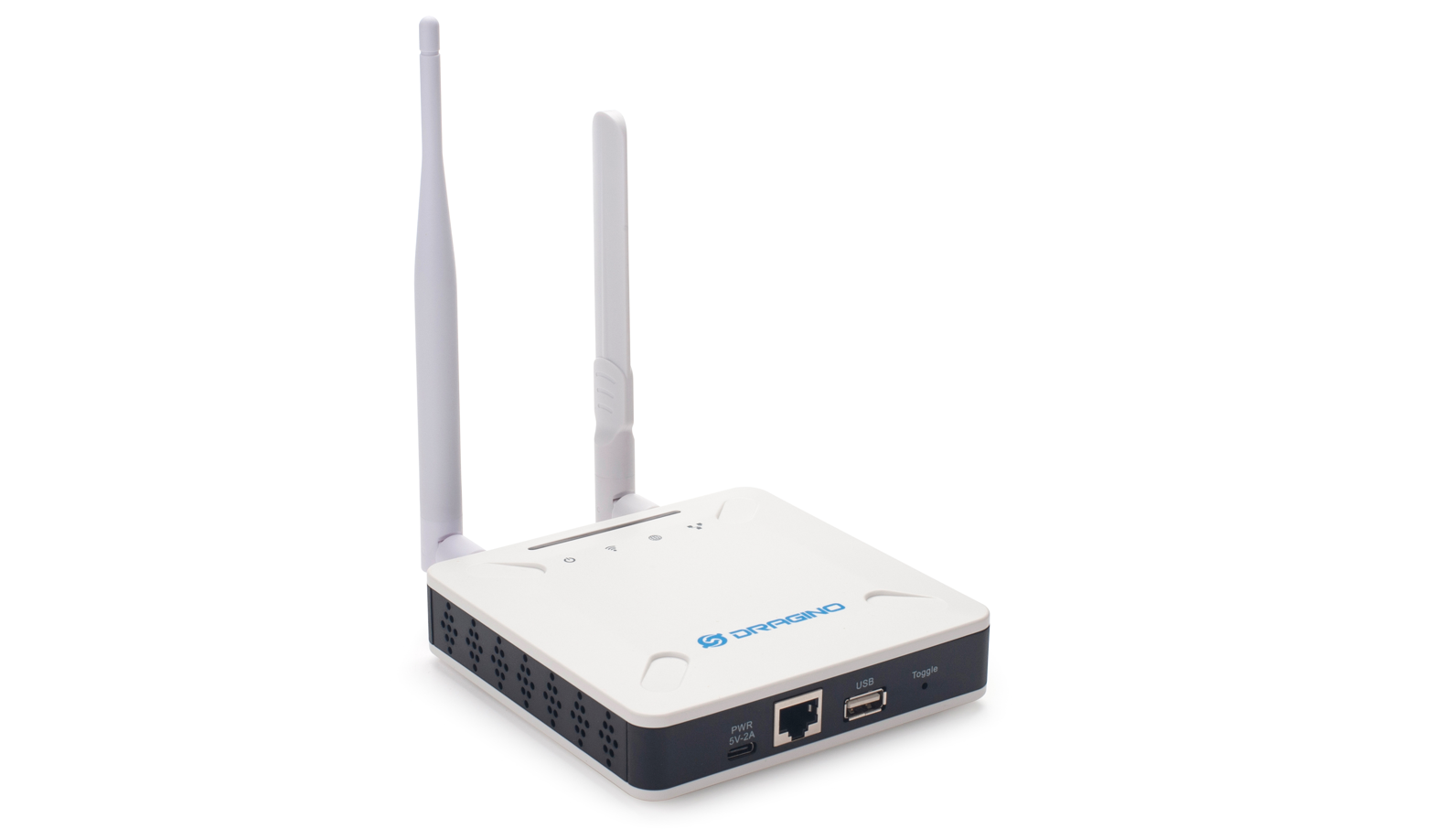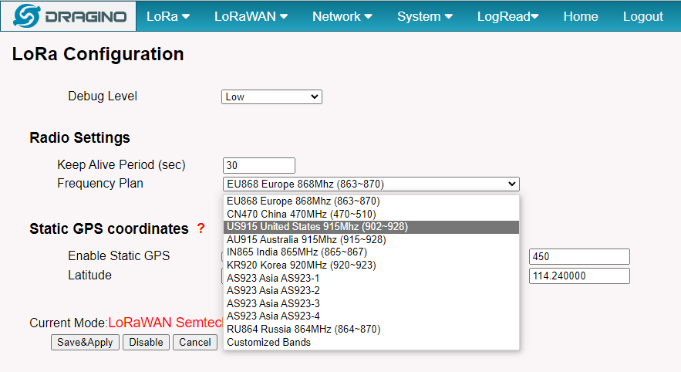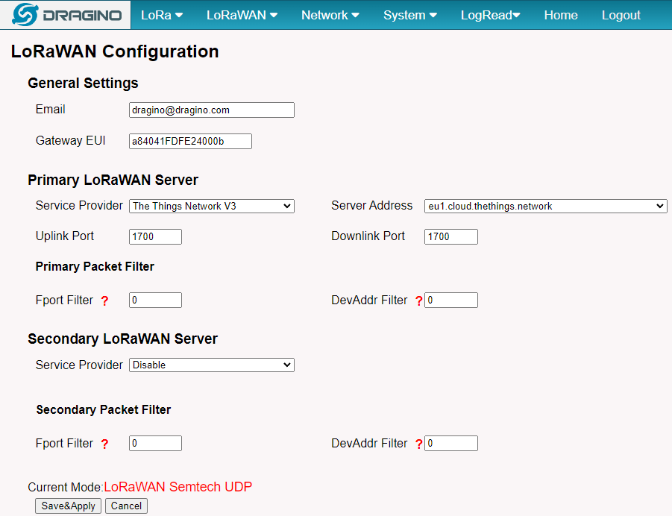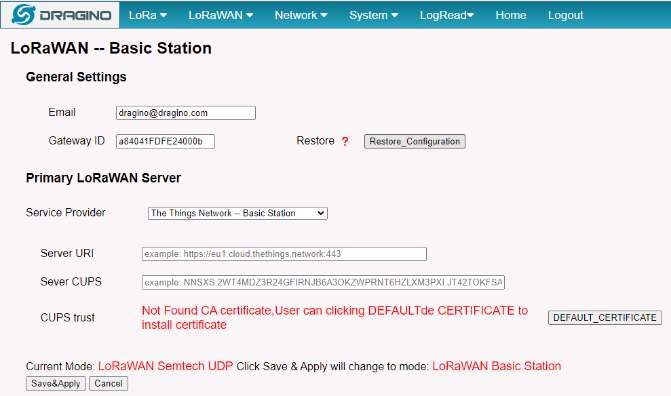
LPS8v2 User Manual
Table of Contents:
- 1. Introduction
- 2. Quick Start
- 3. Web Configure Pages
- 10. Order Info
- 11. Manufacturer Info
- 12. FCC Warning
1. Introduction
1.1 What is LPS8v2
The HP0C is an open-source LoRaWAN Gateway. It lets you bridge LoRa wireless network to an IP network via WiFi, Ethernet. The LoRa wireless allows users to send data and reach extremely long ranges at low data-rates.
HP0C has pre-configured standard LoRaWAN frequency bands to use for different countries. Users can also customize the frequency bands to use in their own LoRaWAN network.
1.2 Specifications
Hardware System:
Linux Part:
- Dragino H3-Core Linux Module
- Quad-core Cortex-A7 1.2Ghz
- RAM: 512MB
- eMMC: 4GB
Interface:
- 10M/100M RJ45 Ports x 1
- LoRaWAN Wireless
Operating Condition:
- Work Temperature: -20 ~ 65°C
- Storage Temperature: -20 ~ 65°C
- Power Input: 5V 2A, DC
1.3 Features
- Open Source Debian system
- Managed by Web GUI, SSH via WAN or WiFi
- Remote access with Reverse-SSH
- Emulates 49x LoRa demodulators
- LoRaWAN Gateway
- 10 programmable parallel demodulation paths
- Pre-configured to support different LoRaWAN regional settings.
- Allow customizing LoRaWAN regional parameters.
- Support Local decode ABP end node info and transfer to MQTT server
- Support different level login.
- Built-in The Things Network local LoRaWAN server
- Built-in Node-Red local Application server
- Built-in local Chirpstack-gateway-bridge
World Widely. Include US and EU
1.4 Block Diagram
2. Quick Start
The LPS8-V2 supports network access via Ethernet or Wi-Fi connection and runs without a network.
In most cases, the first thing you need to do is make the lps8-v2 accessible to the network.
2.1 The LPS8-V2 connects to the network
2.1.1 Method 1: Connect the network via Ethernet,
2.1.2 Method 2: Connect the network via Wi-Fi.
2.2 The LPS8-V2 is registered and connected to The Things Network
3. Web Configure Pages
3.1 Home
Shows the system running status:
3.2 LoRa Settings
3.2.1 LoRa --> LoRa
This page shows the LoRa Radio Settings. There is a set of default frequency bands according to LoRaWAN protocol, and users can customize the band* as well.
Different LPS8v2 hardware versions can support different frequency ranges:
- 868: valid frequency: 863Mhz ~ 870Mhz. for bands EU868, RU864, IN865 or KZ865.
- 915: valid frequency: 902Mhz ~ 928Mhz. for bands US915, AU915, AS923 or KR920
After the user choose the frequency plan, the user can see the actual frequency is used by checking the page LogRead --> LoRa Log

Note *: See this instruction for how to customize the frequency band:
How to customized LoRaWAN frequency band - DRAGINO
3.3 LoRaWAN Settings
3.3.1 LoRaWAN --> LoRaWAN Semtech UDP
This page is for the connection set up to a general LoRaWAN Network server such as TTN, ChirpStack, etc.

3.3.2 LoRaWAN --> LoRaWAN Basic Station
This page is for the connection set up to the TTN Basic Station, AWS-IoT, etc.

Please see this instruction to know more detail and a demo for how to use of LoRaWAN Basic Station: Use of LoRaWAN Basic Station - DRAGINO
3.4 Network Settings
3.4.1 Network --> WiFi

3.4.2 Network --> System Status

3.4.3 Network --> Firewall

3.5 System
3.5.1 System --> System Overview
Shows the system info:
3.5.2 System --> Backup/Restore

3.5.3
10. Supports
If you are experiencing issues and can't solve them, you can send mail to support@dragino.com.
With your question as detailed as possible. We will reply and help you in the shortest.
10. Order Info
LPS8v2-XXX
XXX: Frequency Band
- AS923: LoRaWAN AS923 band
- AU915: LoRaWAN AU915 band
- EU868: LoRaWAN EU868 band
- KR920: LoRaWAN KR920 band
- US915: LoRaWAN US915 band
- IN865: LoRaWAN IN865 band
11. Manufacturer Info
Shenzhen Dragino Technology Development co. LTD
Room 202, Block B, BCT Incubation Bases (BaoChengTai), No.8 CaiYunRoad
LongCheng Street, LongGang District ; Shenzhen 518116,China
12. FCC Warning
This equipment has been tested and found to comply with the limits for a Class B digital device, pursuant to Part 15 of the FCC Rules. These limits are designed to provide reasonable protection against harmful interference in a residential installation. This equipment generates uses and can radiate radio frequency energy and, if not installed and used in accordance with the instructions, may cause harmful interference to radio communications. However, there is no guarantee that interference will not occur in a particular installation. If this equipment does cause harmful interference to radio or television reception, which can be determined by turning the equipment off and on, the user is encouraged to try to correct the interference by one or more of the following measures:
-- Reorient or relocate the receiving antenna.
-- Increase the separation between the equipment and receiver.
-- Connect the equipment into an outlet on a circuit different from that to which the receiver is connected.
-- Consult the dealer or an experienced radio/TV technician for help.
Changes or modifications not expressly approved by the party responsible for compliance could void the user's authority to operate the equipment.
The antenna(s) used for this transmitter must be installed to provide a separation distance of at least 20 cm from all persons and must not be co-located or operating in conjunction with any other antenna or transmitter.